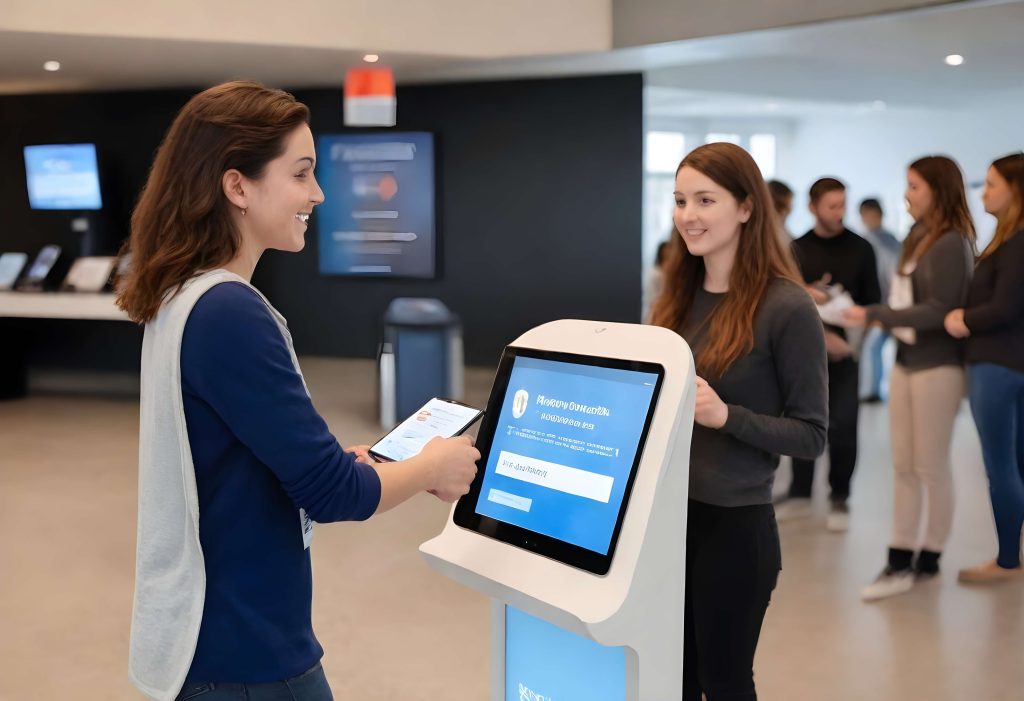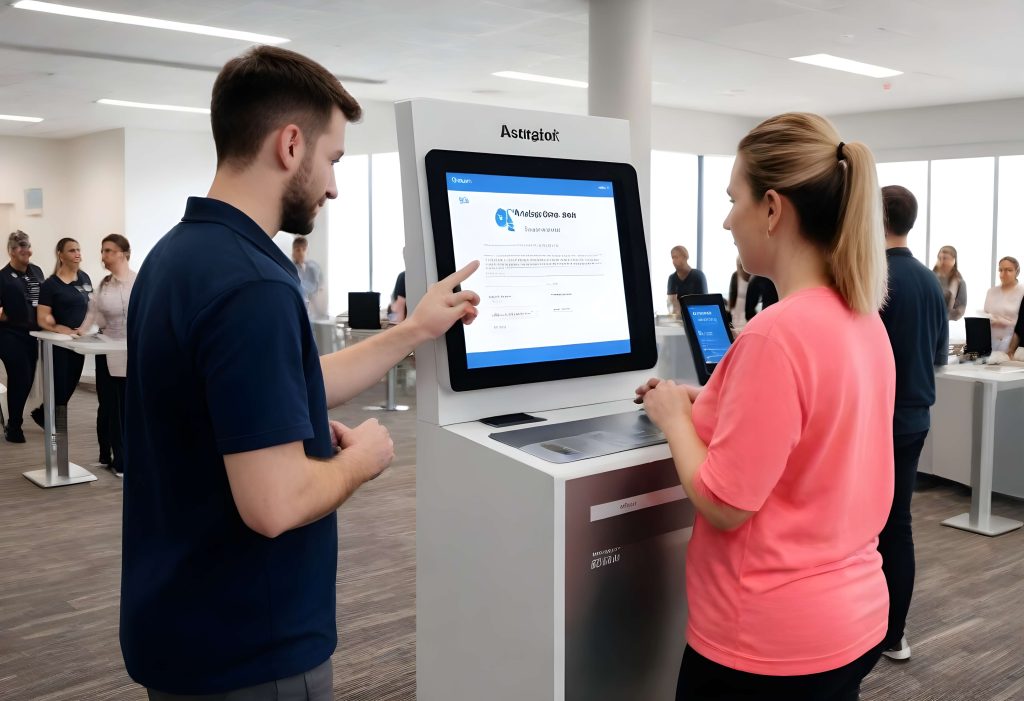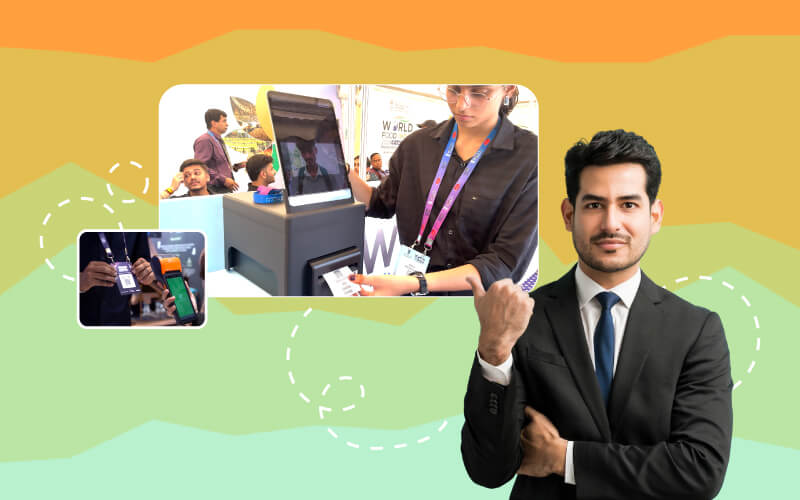An effective event registration procedure is essential. It makes an initial impression on attendees and contributes to a higher turnout. Organizers are turning to technical solutions to achieve a smooth, effective, and interesting event. Onsite event registration kiosks have become a game-changer among all of the others. They have altered the field of event planning and management. These kiosks have helped to simplify the most important and stressful portion of the event. Event registration management and ticketing kiosks can be integrated with any event ticketing solution, which enhances the whole process.
What Is an Onsite Event Registration Kiosk?
Self-registration kiosks make it simple for attendees to register for your event. These might be stand-alone computers, laptops, or tablets that are online and linked to your event management program. They can also be coupled with additional devices, such as printers, scanners, cameras, and payment terminals.

Event registration kiosks located on-site expedite the check-in procedure and minimize waiting periods. They can make badges, gather data on attendance, and give maps and timetables for the events. The overall experience for participants is enhanced by these kiosks, which make registration simple, quick, and effective. They can be especially useful for large events, where human check-in processes could be time-consuming and prone to errors.
Features of On-Site Event Registration Kiosk
Event registration kiosks have emerged as a dynamic solution revolutionizing the event management landscape, offering you and your attendees many benefits. Look for these features before selecting a registration kiosk:
User-Friendly Interface
Using a simple interface, attendees should be able to register themselves at the on-site event registration kiosk with ease. Typically, large buttons, easily readable instructions, and touchscreen capabilities are incorporated to make the registration process straightforward for customers to finish.
Customizable Registration Forms
One of the main advantages of the onsite event registration kiosk is its ability to offer personalized registration forms. Event organizers can use these forms to collect specific information from attendees, such as names, contact details, dietary requirements, and preferred programs. This flexibility ensures that the registration process is tailored to each event’s unique requirements.

Real-Time Data Capture and Reporting
The technology installed in the kiosk makes it possible to gather and report data instantly. As attendees register at the kiosk, their information is instantly taken and securely stored in the system. With real-time access to this data, event planners may keep an eye on registration numbers, demographics, and other important characteristics. This tool helps event planners make educated decisions and adjustments to enhance the attendance experience throughout the event.
Integration With Event Management Software
Another notable feature is the seamless integration of the on-site event registration kiosk with event management software. This interface reduces the potential for errors by eliminating the requirement for human data to be entered at the kiosk. Alternatively, the event management software may quickly sync registration data. Event coordinators may speed the planning process by handling guest data, sending out automated confirmations, and generating reports all through one system.
Benefits of Onsite Event Registration
Offering on-site event registration to guests is a terrific approach to improve the overall experience. Simplifying the difficult work improves the event’s efficiency and reduces the burden on the organizers. Below are some essential benefits of onsite registration.
Cost Efficiency
Restricting badge printing to visitors who have registered reduces the likelihood of material waste and overprinting costs. Furthermore, on-demand printing eliminates the need for pre-printed badges to be sent to the event site, reducing costs and logistical challenges.
Furthermore, by employing digital technologies for badge production and registration, processes may be expedited to reduce labor costs and time. Putting cost-effective strategies into practice, including using recyclable materials for badges or mass printing reductions, can further improve savings. The efficacy of budgets and resource allocation may be enhanced by event planners through ongoing evaluation and enhancement of cost-cutting tactics.
Enhanced Security
On-demand badge printing enables the integration of complex security features like barcodes, QR codes, or RFID technology. Enhancing event security, these features—which allow for speedy verification and block unauthorized access—can be generated dynamically for each visitor.

Real-time monitoring of credential printing activities can enhance event security by helping to spot any suspicious activity or irregularities. Tracking badge usage and access patterns yields valuable insights for optimizing security protocols and promptly mitigating any hazards. Event organizers may provide a secure environment for attendees and staff by putting these enhanced security measures into place.
Streamlined Check-in Process
Because of on-site badge printing kiosks, attendees may quickly acquire their credentials upon arrival, expediting the check-in process. As a consequence, the event experience is more efficient and smooth overall, with lower wait times and queues.
In addition, the accelerated check-in process allows guests to access the venue quickly and avoid unnecessary lines, ensuring an early start to the festivities. The elimination of the need for manual credential distribution frees up resources, allowing event coordinators to focus on enhancing other program components. Convenient ways to increase participants’ satisfaction and foster a positive perception of the event as a whole include on-site credential printing kiosks.
Dynamic Attendee Information
Using onsite badge printing, event planners may get the most recent attendance figures. This is especially useful for events when registration is still open since it guarantees that all attendees, including those who register on the day of the event, will receive a personalized badge with the most recent information.
Additionally, dynamic attendee data enables event planners to more efficiently track attendance and quickly adjust the program as necessary. By customizing experiences and maintaining up-to-date attendance records, event organizers may better tailor their events to the preferences and needs of attendees. This level of customization can increase participants’ overall satisfaction and engagement.
Tips for Selecting the Right Event Check-in Kiosk
Selecting the ideal event check-in kiosk is crucial as it will aid in the smooth operation of the whole event and ensure that all criteria are met. The following advice will help you choose the ideal kiosks for your event.
Consider Event Size and Type
Before installing event registration kiosks, you must determine the event’s size and type in order to choose the best possible option. You could desire a scalable solution for larger events, while simplicity and economy can be more important for smaller ones..
Integration Capabilities
The ability to integrate an event check-in kiosk is a crucial component to take into account when assessing the kiosk’s potential success. Event planners should evaluate how effectively the kiosk connects with the chosen event management and other software in order to ensure proper data transmission.
Additionally, seamless connectivity can raise the general efficacy of event operations by streamlining processes and reducing human errors. A well-integrated event check-in kiosk may provide organizers with up-to-date information and statistics, enabling them to make educated decisions on the spot. Ultimately, it improves the experience’s smoothness and intrigue for both attendees and event planners.
User Support and Training
As the event planner, it is your responsibility to make sure that your personnel is not only aware of the self-event check-in kiosk you have incorporated but also understands how to utilize it. The service provider’s guidance and support are important to the overall solution.

The smooth functioning of the self-event kiosk is mostly dependent on user assistance and training. While prompt user support may address any issues that may arise during the event, staff members’ understanding and use of the system may be enhanced by well-designed training. By prioritizing user support and training, event planners may optimize the efficacy and efficiency of their self-event check-in process.
The Bottom Line
One excellent feature that may quickly help streamline the entire event management process is the use of kiosks for registration. They are a fantastic addition to delivering a smooth and improved event experience. These kiosks improve the performance of events overall by cutting down on wait times and lengthy lines, personalizing encounters, and gathering data in real-time. With the rapid advancement of technology, adding event registration kiosks for attendees is a smart approach to making a lasting impression.







